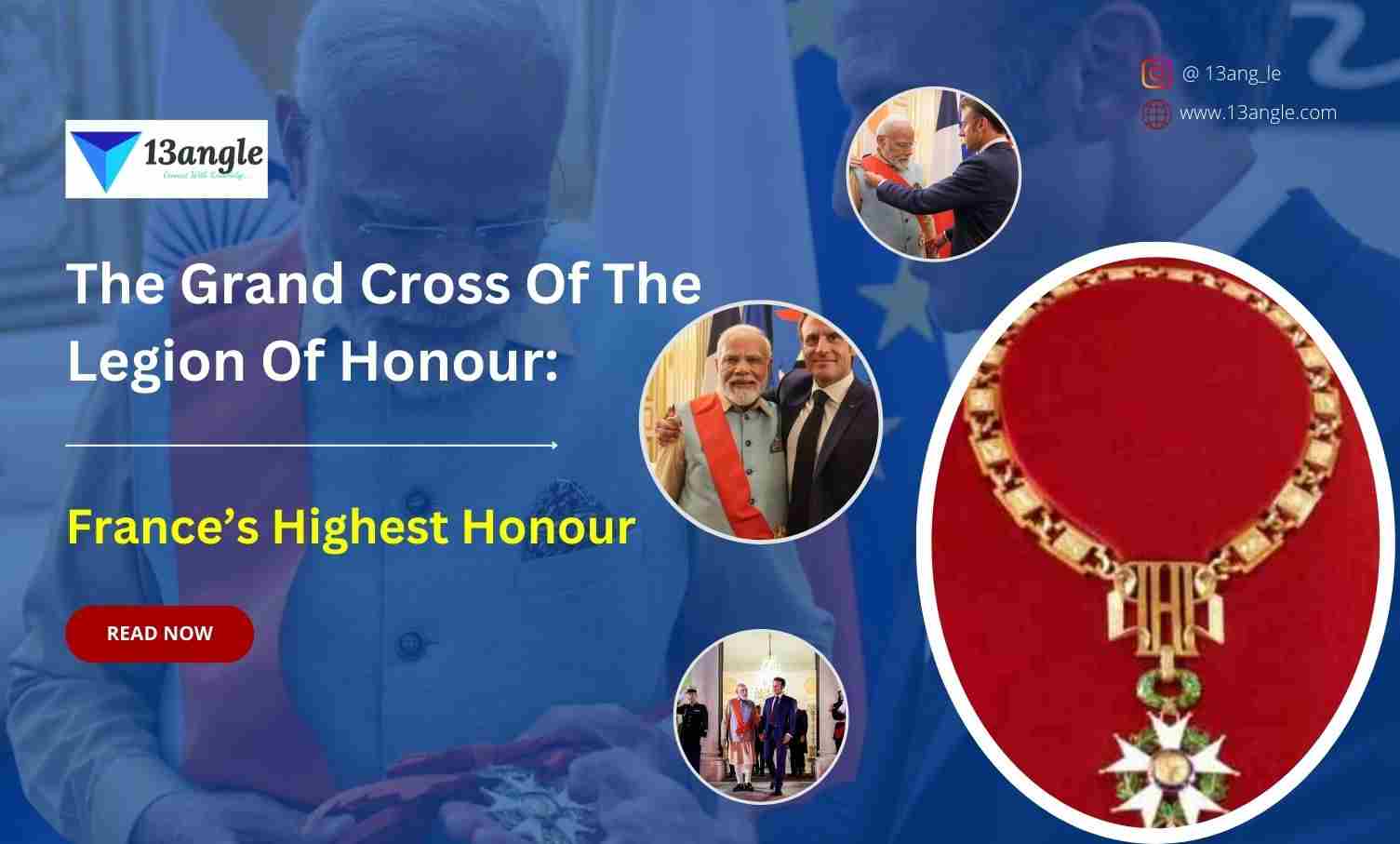- Umang Sagar
- Award
The Grand Cross Of The Legion Of Honour: France’s Highest Honour
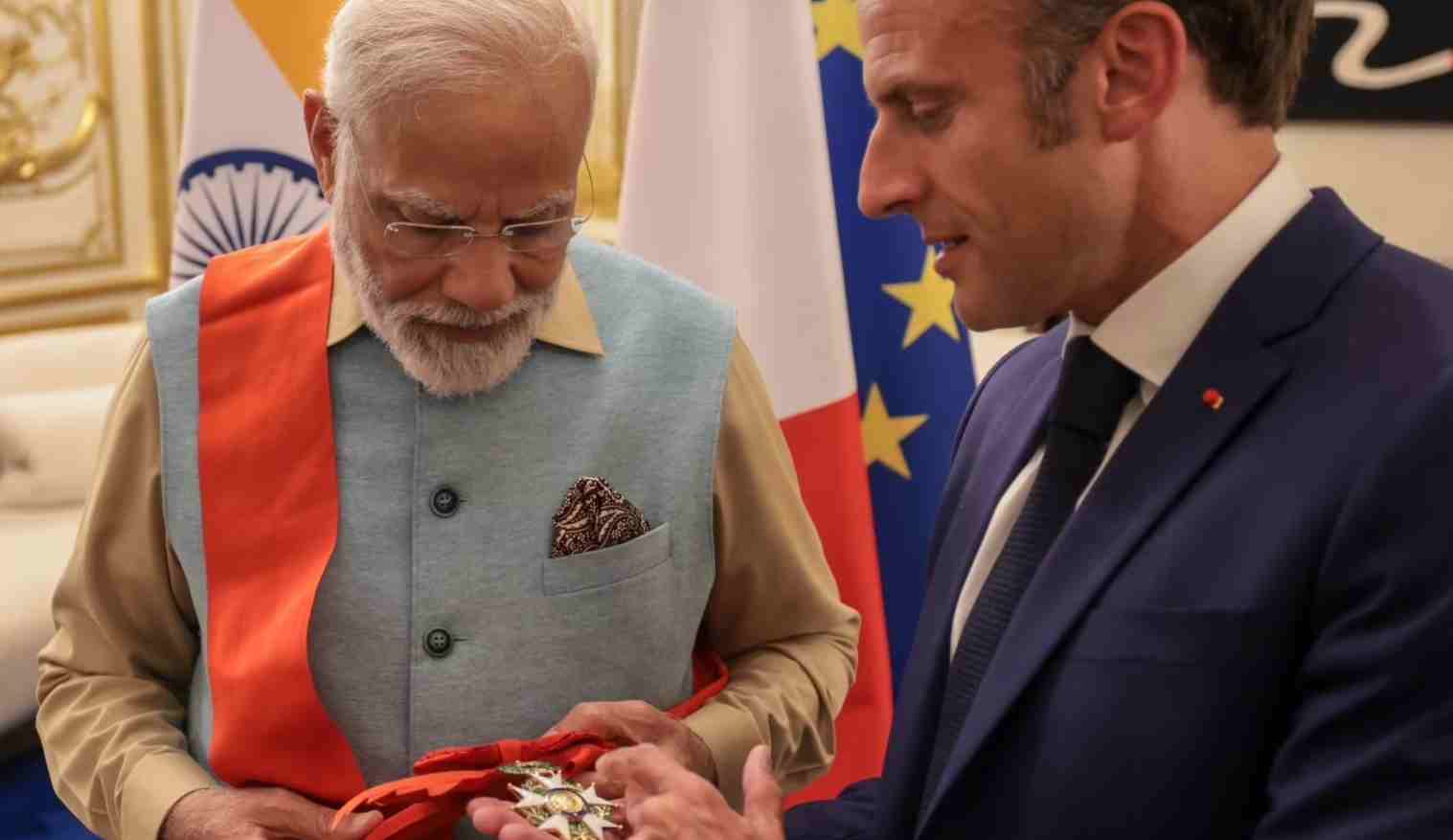
Introduction
The Grand Cross of the Legion of Honour, or “Grand Croix de la Légion d’Honneur” in French, holds a position of utmost prestige as France’s highest honour. Established by Napoleon Bonaparte in 1802, the Legion of Honour is an esteemed order of merit that recognizes exceptional contributions to France and humanity. The Grand Cross, as the pinnacle of this distinguished order, is bestowed upon individuals who have demonstrated extraordinary achievements and service, symbolizing the highest level of recognition and honour within French society.
The historical significance of the Grand Cross dates back to the time of Napoleon, who sought to establish an order that would reward military and civilian merit alike. The Legion of Honour was conceived as a means to honour those who had shown exceptional dedication, loyalty, and leadership in service to France. Over the years, it has evolved into a symbol of the nation’s gratitude to individuals who have made remarkable contributions in diverse fields such as politics, diplomacy, science, arts, and culture.
As an honour of such high regard, the Grand Cross of the Legion of Honour represents not only individual achievement but also the values and aspirations of the entire nation. It symbolizes excellence, selflessness, and the relentless pursuit of greatness. Being awarded the Grand Cross is a testament to an individual’s outstanding accomplishments and significant impact on society, reflecting their commitment to the ideals of the Legion of Honour.
The criteria for receiving the Grand Cross are stringent, requiring prior recognition within the Legion of Honour and the demonstration of unparalleled merit in one’s respective field. The decision to award this prestigious distinction is made by the President of France, who serves as the Grand Master of the Legion of Honour. The selection process involves a meticulous evaluation of the nominee’s contributions, achievements, and dedication to the betterment of France and humanity.
The insignia of the Grand Cross is imbued with profound symbolism. It consists of a gold Maltese cross with arms adorned in white enamel, signifying purity and integrity. The cross is embellished with laurel leaves, representing victory and honour, and oak leaves, symbolizing strength and resilience. At the centre, a medallion depicts the head of the Republic, emphasizing the connection between the recipient’s achievements and the nation. This grand insignia is worn on a distinguished crimson sash, symbolizing valour and distinction.
Prominent individuals from various domains, including statesmen, military leaders, artists, writers, scientists, and humanitarians, have been honoured with the Grand Cross of the Legion of Honour. These esteemed recipients have left an indelible mark on society through their exceptional contributions and have embodied the highest ideals of the Legion of Honour. Their names and achievements serve as an inspiration to future generations, underscoring the transformative power of dedication, excellence, and selflessness.
Historical Significance
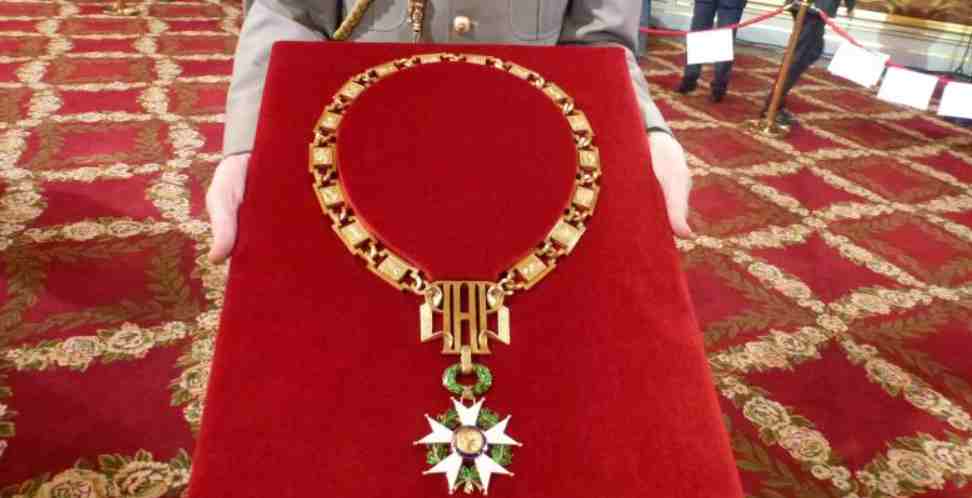
The Grand Cross of the Legion of Honour holds profound historical significance, rooted in the establishment of the Legion of Honour by Napoleon Bonaparte in 1802. During a time of significant political and social change, Napoleon sought to create an order that would honour individuals who had shown exceptional merit and service to France, both in military and civilian spheres.
The Legion of Honour was envisioned as a way to recognize and reward those who demonstrated exemplary leadership, loyalty, and dedication to the nation. It aimed to unite individuals from different backgrounds under a common mission of upholding the ideals of France and promoting its prosperity. This prestigious order represented a departure from the hereditary privileges of the old regime and emphasized meritocracy and the potential for social advancement based on one’s accomplishments.
Napoleon himself played an instrumental role in the establishment of the Legion of Honour, personally bestowing the honour upon those he deemed worthy. He sought to create a distinguished order that would not only acknowledge military valour but also reward civilian achievements in fields such as science, arts, literature, and industry. By expanding the criteria for recognition, Napoleon aimed to inspire individuals to excel in various domains and contribute to the advancement of France.
The Legion of Honour quickly gained prominence and became a highly sought-after honour among the French population. It served as a unifying force, bringing together individuals from different backgrounds and professions who shared a common commitment to the nation. The order instilled a sense of pride and national identity, fostering a culture of excellence and service.
Throughout history, the Legion of Honour, and particularly the Grand Cross, has been awarded to individuals who have made significant contributions to France and the world. Prominent recipients have included statesmen, military leaders, artists, writers, scientists, and humanitarians. By recognizing their achievements, the Legion of Honour has played a pivotal role in acknowledging and celebrating the impact of these exceptional individuals on society.
The historical significance of the Grand Cross lies in its continuity and the enduring legacy of the Legion of Honour. It has become a symbol of French national pride, reflecting the nation’s appreciation for those who have contributed to its advancement and embody its values. The Grand Cross stands as a testament to the enduring importance of recognizing and honouring exceptional individuals who have made remarkable contributions in their respective fields.
Criteria For Award
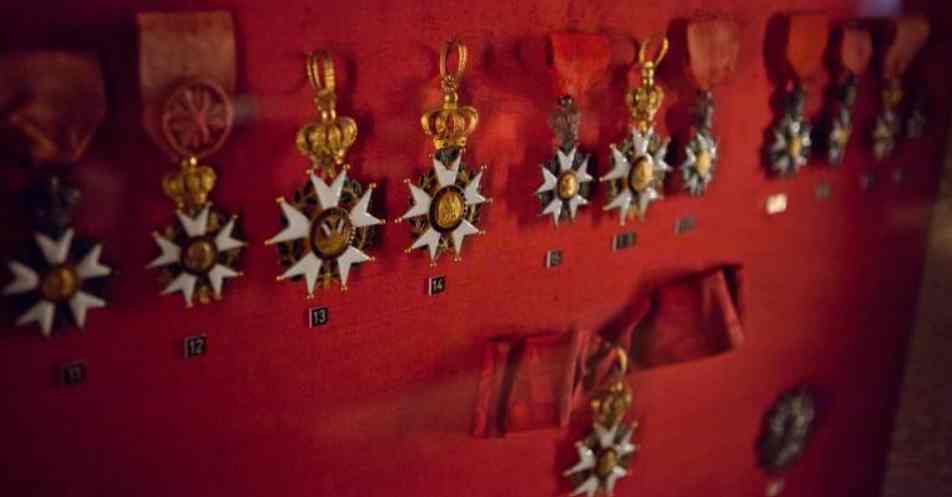
The Grand Cross of the Legion of Honour, France’s highest honour, is bestowed upon individuals who have demonstrated exceptional merit, service, and dedication to France and humanity. The criteria for receiving this prestigious distinction are stringent, reflecting the significance and exclusivity of the award.
1. Previous Recognition within the Legion of Honour:
To be eligible for the Grand Cross, an individual must have already received lower ranks within the Legion of Honour. These ranks include Knight (Chevalier), Officer (Officier), Commander (Commandeur), and Grand Officer (Grand Officier). Each progressive rank signifies increasing levels of achievement and contribution. The Grand Cross is the pinnacle of this honour, reserved for those who have reached the highest echelons of recognition within the Legion of Honour.
2. Extraordinary Merit and Achievements:
Recipients of the Grand Cross must have demonstrated exceptional merit and made significant contributions in their respective fields. This may include extraordinary accomplishments in politics, diplomacy, science, arts, culture, literature, humanitarian work, or any other domain that has positively impacted society. The Grand Cross recognizes individuals who have gone above and beyond the call of duty, exhibiting exceptional leadership, vision, and dedication to their endeavours.
3. Impact on France and Humanity:
The Grand Cross is awarded to individuals who have made a profound and lasting impact on France and humanity as a whole. Their contributions should transcend personal success and benefit society at large. Recipients are often individuals who have shaped the course of history, contributed to the advancement of knowledge, promoted peace and diplomacy, or made significant strides in improving the lives of others. Their achievements should have a far-reaching influence and be recognized as exceptional on a national and international scale.
4. Approval by the President of France:
The decision to award the Grand Cross is made by the President of France, who serves as the Grand Master of the Legion of Honour. The President carefully evaluates the nominations, considering the accomplishments, impact, and dedication of the individuals. The selection process involves a thorough assessment of the nominee’s achievements and their alignment with the values and objectives of the Legion of Honour. The President’s approval ensures that the highest standards of excellence and service are upheld.
The criteria for the Grand Cross of the Legion of Honour ensure that only the most exceptional individuals receive this prestigious honour. It reflects a commitment to recognizing those who have made significant contributions to France and society, inspiring others through their achievements and embodying the values of the Legion of Honour.
The Grand Cross of the Legion of Honour is awarded based on stringent criteria that encompass previous recognition within the Legion of Honour, extraordinary merit and achievements, significant impact on France and humanity, and the approval of the President of France. These criteria uphold the exclusivity and prestige of the Grand Cross, ensuring that it is bestowed upon individuals who have demonstrated unparalleled dedication, excellence, and service in their respective fields.
Symbolism And Insignia
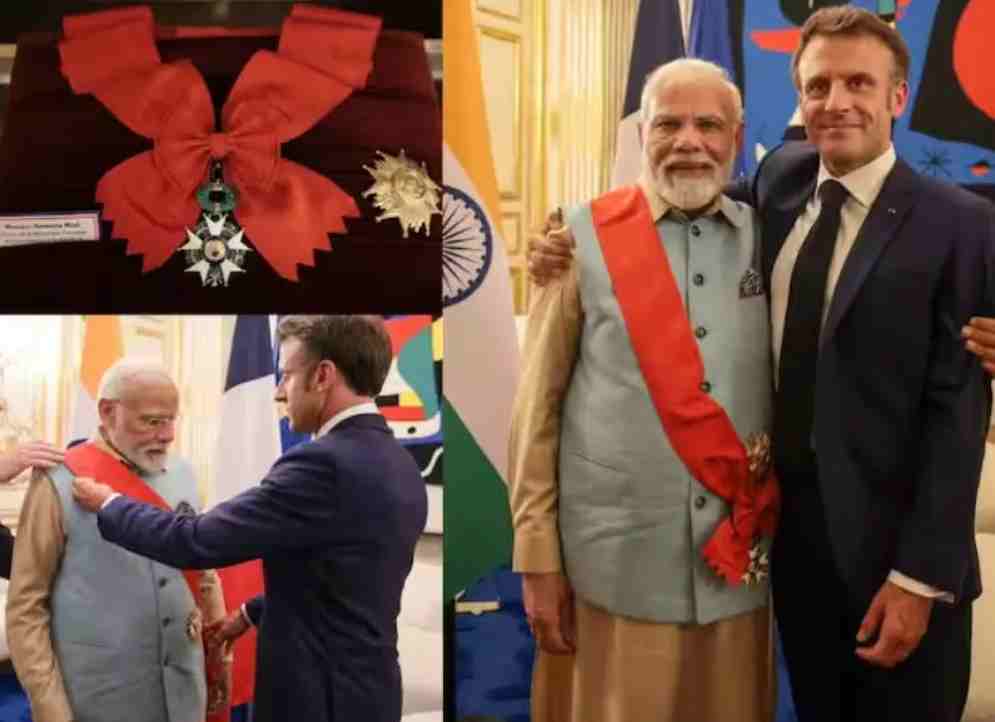
The Grand Cross of the Legion of Honour is adorned with intricate symbolism, reflecting the values and ideals associated with this highest honour. The insignia of the Grand Cross is visually striking and carries profound meaning, serving as a tangible representation of the distinguished rank within the Legion of Honour.
1. The Maltese Cross:
The central element of the insignia is the Maltese Cross, a symbol associated with the historical Order of St. John. It consists of four arms of equal length, each terminating in a trefoil shape. The Maltese Cross signifies chivalry, honour, and bravery, evoking a sense of noble ideals and virtue.
2. White Enamel:
The arms of the cross are adorned with white enamel, representing purity, integrity, and moral character. This colour choice emphasizes the importance of upholding ethical standards and the highest principles in one’s actions and service.
3. Central Medallion:
At the centre of the cross, there is a medallion depicting the head of the Republic. This medallion serves as a symbol of the nation, connecting the recipient’s achievements with the ideals and values of France. It represents the profound bond between the individual’s contributions and their impact on the nation as a whole.
4. Laurel Leaves and Oak Leaves:
The Grand Cross is embellished with laurel leaves and oak leaves, symbolizing victory, honour, strength, and resilience. The laurel leaves are associated with achievement, accomplishment, and glory, while the oak leaves represent fortitude, steadfastness, and endurance. Together, they signify the remarkable achievements and unwavering dedication of the recipient.
5. Crimson Sash:
The Grand Cross is worn on a distinguished crimson sash, which holds its own significance. The crimson colour is traditionally associated with nobility, royalty, and valour. It represents the courage, sacrifice, and selflessness of those who have been bestowed with this honour. The sash symbolizes the distinguished rank of the Grand Cross and serves as a visual marker of the recipient’s exceptional achievements.
6. Breast Star:
In addition to the insignia worn on the sash, recipients of the Grand Cross are also entitled to wear a breast star on formal occasions. The breast star is a smaller version of the cross and is typically crafted in gold or silver, adorned with enamel and embellishments. It further showcases the esteemed rank of the Grand Cross and serves as a visible symbol of the recipient’s exceptional accomplishments.
The symbolism and insignia of the Grand Cross of the Legion of Honour convey a profound sense of honour, virtue, and national pride. Each element, from the Maltese Cross to the laurel leaves and oak leaves is carefully chosen to represent the values and ideals associated with this highest honour. The insignia, worn on a crimson sash and often accompanied by a breast star, serves as a tangible representation of the recipient’s exceptional achievements and their enduring impact on France and society.
Recipients, Selection, Refusal, Revocation, And Appearance
The Legion of Honour, with its extensive membership and esteemed reputation, highlights the exceptional contributions of individuals across various domains. The selection process relies on the recommendations of French ministers and a wide societal network. While refusal is rare, revocation can occur in cases of dishonourable actions. The distinct appearance of the Legion of Honour’s insignia, including the red ribbon and symbolic design, signifies the honour and pride associated with its recipients. Wearing the cross on the left-hand side showcases its precedence over other insignia. The Legion of Honour continues to symbolize excellence and service, honouring those who have made significant contributions to France and society at large.
1. Number of Recipients: The Legion of Honour Membership
The Legion of Honour has an impressive membership of 79,000 individuals. Each year, an average of 2,200 French citizens and 300 foreigners are decorated with this prestigious honour.
2. Selection Process: Identification of Potential Honourees
The Legion of Honour cannot be applied for. French ministers are responsible for identifying potential honourees, relying on a broad societal network that includes parliamentarians, mayors, employers, leaders of trade unions or non-profit organizations, and presidents of professional or sports federations.
3. Refusal: Objecting to the Legion of Honour
Some individuals express their objection to the Legion of Honour in principle, even though they have not received it. In these cases, it is not considered a refusal. However, in rare instances, individuals who have been admitted to the Order may choose not to receive the decoration.
4. Revocation: Grounds for Revocation
The Legion of Honour can be revoked if a recipient is convicted of a crime or engages in dishonourable actions that may harm the interests of France. Revocation is announced by decree, and it is a serious measure taken to maintain the integrity and reputation of the honour.
5. The appearance of the Insignia: The Ribbon and Badge
The Legion of Honour is visually distinguished by its red ribbon. The badge features a five-armed Maltese asterisk suspended from an oak and laurel wreath. The obverse side bears the effigy of the Republic, while the reverse side depicts two tricolour flags surrounded by the motto “Honneur et Patrie” (Honour and Fatherland).
6. Wearing the Cross: Placement and Attire
The Legion of Honour is traditionally worn on the left-hand side before any other French or foreign insignia. For informal attire, lapel insignia such as a ribbon or rosette is preferred. Pendants and small-size decorations are commonly worn during official ceremonies. It’s important to note that the military follows its own specific rules for wearing insignia.
7. Degrees of the Legion of Honor:
The Legion of Honor consists of five degrees, reflecting different levels of distinction:
- Knight (Chevalier)
- Officer (Officier)
- Commander (Commandeur)
- Grand Officer (Grand Officier)
- Grand Cross (Grand-Croix)
8. Notable Awardees:
Prominent leaders and figures who have been honoured with the Legion of Honour include:
- Former President of South Africa Nelson Mandela
- King Charles – the then Prince of Wales (now King of Britain)
- Former Chancellor of Germany Angela Merkel
- Former Secretary-General of the United Nations Boutros Boutros-Ghali
- Russian President Vladimir Putin
- Indian Prime Minister Narendra Modi was awarded the highest degree, the Grand Cross.
Prominent Recipients
Over the years, numerous illustrious individuals from various fields have been honoured with the Grand Cross of the Legion of Honour. Among them are renowned statesmen, military leaders, artists, writers, scientists, and humanitarians. Prominent recipients include Charles de Gaulle, Winston Churchill, Nelson Mandela, Albert Schweitzer, Marie Curie, Pablo Picasso, Audrey Hepburn, and Narendra Modi. These individuals exemplify the highest ideals of the Legion of Honour and have made lasting contributions to their respective domains.
Impact And Legacy
The Grand Cross of the Legion of Honour holds an immense impact and leaves a lasting legacy in the lives of recipients, French society, and the global community. This highest honour within the Legion of Honour recognizes individuals who have made exceptional contributions, and its impact extends far beyond the moment of receiving the award.
1. Validation and Recognition:
For recipients, the Grand Cross serves as a validation of their lifetime of outstanding achievements and contributions. It is a tangible symbol of recognition for their dedication, leadership, and exceptional service to France and humanity. The honour brings a deep sense of pride and accomplishment, affirming their impact and the value of their work. The recognition instills a profound sense of fulfilment, inspiring recipients to continue their endeavours and serve as role models for future generations.
2. Inspiration and Aspiration:
The Grand Cross of the Legion of Honour serves as an inspiration to individuals across society. The recipients’ stories of remarkable achievements, selflessness, and dedication inspire others to aim for greatness, push boundaries, and make a positive impact in their own fields of endeavour. Honour becomes a beacon of aspiration, encouraging individuals to strive for excellence, embrace leadership, and contribute to the betterment of society. The legacy of the Grand Cross transcends the individual recipients and ignites a collective spirit of achievement and service.
3. Preservation of Values:
The Grand Cross upholds and preserves the core values of the Legion of Honour. It reinforces the ideals of honour, integrity, dedication, and selflessness. By recognizing individuals who embody these values, honour reinforces their importance in society. The legacy of the Grand Cross ensures that these values are cherished, upheld, and transmitted to future generations, fostering a culture of excellence, service, and societal contribution.
4. National and International Impact:
Recipients of the Grand Cross often hold influential positions or have achieved remarkable milestones in their respective domains. Their impact extends beyond France, shaping global discourse, diplomacy, culture, and scientific advancements. The honour elevates their platform and provides an opportunity to amplify their messages, initiatives, and causes. The Grand Cross serves as a testament to the power of individual actions and contributions in shaping the world and making a positive difference on a national and international scale.
5. Perpetuation of Excellence:
The legacy of the Grand Cross perpetuates a cycle of excellence and achievement. Recipients inspire others to reach for greatness, fostering a culture of continuous improvement and dedication to one’s craft. The honour encourages individuals to surpass their own limitations, embrace challenges, and leave a lasting impact on society. The Grand Cross sets a high standard for future generations, motivating them to strive for greatness and contribute to the betterment of their communities and the world at large.
Conclusion
The Grand Cross of the Legion of Honour stands as a pinnacle of recognition and honour within the esteemed Legion of Honour. It represents the highest level of achievement and service, bestowed upon individuals who have demonstrated exceptional merit, dedication, and contributions to France and humanity. The impact and legacy of this prestigious honour are profound, encompassing the lives of recipients, French society, and the global community.
For recipients, the Grand Cross serves as a profound validation and recognition of their outstanding accomplishments and selfless service. It affirms the value and impact of their work, instilling a deep sense of pride, fulfilment, and inspiration. The honour becomes a lifelong symbol of distinction, reminding recipients of their remarkable achievements and encouraging them to continue their endeavours with renewed vigor and purpose.
The impact of the Grand Cross extends beyond the individual recipients. It serves as an inspiration and aspiration for individuals across society, encouraging them to strive for greatness, embrace leadership, and make a positive impact in their respective fields. The honour becomes a beacon of hope and excellence, motivating future generations to reach for extraordinary achievements and contribute to the betterment of society.
Moreover, the Grand Cross preserves and upholds the core values of the Legion of Honour. It reinforces the ideals of honour, integrity, dedication, and selflessness, fostering a culture of excellence and service. The legacy of the Grand Cross ensures that these values are cherished and transmitted to future generations, creating a lasting impact on French society and beyond.
The Grand Cross of the Legion of Honour also holds national and international significance. Recipients, often influential figures in their domains, have made substantial contributions that transcend borders, shaping global discourse, diplomacy, culture, and scientific advancements. The honour elevates their platform, providing an opportunity to amplify their messages, initiatives, and causes, thereby furthering their impact on a global scale.
Furthermore, the Grand Cross perpetuates a cycle of excellence and achievement. Recipients inspire others to surpass their own limitations, embrace challenges, and leave a lasting impact on society. The honour sets a high standard for future generations, motivating them to strive for greatness, and perpetuating a culture of continuous improvement and dedication to one’s craft.
The Grand Cross of the Legion of Honour is a prestigious honour that holds immense significance and impact. It represents the pinnacle of recognition for exceptional merit, dedication, and service to France and humanity. The honour validates the remarkable achievements of recipients, inspiring them and future generations to reach for greatness, contribute to society, and uphold the values of the Legion of Honour. The Grand Cross leaves a lasting legacy, perpetuating excellence, and shaping the lives of recipients, French society, and the global community.
Top 13 Facts About The Grand Cross Of The Legion Of Honour
Highest Honour: The Grand Cross of the Legion of Honour is the highest rank within the Legion of Honour, which is the highest national order of merit in France.
Established by Napoleon Bonaparte: The Legion of Honour was established by Napoleon Bonaparte on May 19, 1802, as a way to recognize exceptional merit and service to France.
Signifies Extraordinary Achievements: The Grand Cross is awarded to individuals who have demonstrated extraordinary achievements and significant contributions in various fields, including politics, diplomacy, science, arts, culture, and humanitarian work.
Symbol of Prestige: The Grand Cross symbolizes the pinnacle of recognition and prestige within the Legion of Honour, representing the highest level of honour that can be bestowed upon an individual.
Rigorous Selection Process: The decision to award the Grand Cross is made by the President of France, who serves as the Grand Master of the Legion of Honour. The selection process involves a thorough evaluation of the nominee’s accomplishments, contributions, and alignment with the values of the Legion of Honour.
Recognition of Service to France: The Grand Cross is awarded to individuals who have made significant contributions to France and have demonstrated unwavering dedication to the betterment of the nation.
International Recognition: While primarily recognizing service to France, the Grand Cross is also bestowed upon individuals from other countries who have made remarkable contributions to humanity.
Limited Number of Recipients: The Grand Cross is awarded sparingly, ensuring its exclusivity and preserving its significance. Only a select number of individuals receive this highest honour within the Legion of Honour.
Insignia: The insignia of the Grand Cross consists of a gold Maltese Cross with white enamel, laurel leaves, oak leaves, and a central medallion depicting the head of the Republic. It is worn on a distinguished crimson sash.
Exceptional Recipients: Prominent recipients of the Grand Cross include heads of state, military leaders, renowned artists, scientists, writers, and humanitarians who have made a lasting impact on society.
Inspiring Future Generations: The Grand Cross serves as an inspiration for future generations, encouraging individuals to strive for excellence, embrace leadership, and contribute to the betterment of society.
Recognition of Sacrifice: The Grand Cross honours individuals who have made personal sacrifices and demonstrated selflessness in their pursuit of service and achievement.
Perpetuation of Values: The Grand Cross perpetuates the core values of the Legion of Honour, including honour, integrity, dedication, and selflessness, promoting these ideals within French society and beyond.
FAQs
The Grand Cross of the Legion of Honour is the highest rank within the Legion of Honour, which is the highest national order of merit in France.
The Grand Cross is the highest honor within the Legion of Honour, bestowed upon individuals who have demonstrated exceptional merit, service, and contributions to France and humanity.
The Legion of Honour was established by Napoleon Bonaparte on May 19, 1802, as a way to recognize exceptional merit and service to France.
The Grand Cross symbolizes the pinnacle of recognition and prestige within the Legion of Honour. It represents the highest level of honour that can be bestowed upon an individual.
The decision to award the Grand Cross is made by the President of France, who serves as the Grand Master of the Legion of Honour. The selection process involves a thorough evaluation of the nominee’s accomplishments, contributions, and alignment with the values of the Legion of Honour.
The Grand Cross is awarded to individuals who have demonstrated extraordinary achievements, significant contributions, and unwavering dedication to France and humanity in various fields.
Yes, individuals from other countries can receive the Grand Cross if they have made remarkable contributions to humanity.
The Grand Cross is awarded sparingly, ensuring its exclusivity. Only a select number of individuals receive this highest honour within the Legion of Honour.
The insignia of the Grand Cross, including the gold Maltese Cross with white enamel, laurel leaves, oak leaves, and a central medallion, represents honour, integrity, achievement, and service.
Prominent recipients of the Grand Cross include heads of state, military leaders, renowned artists, scientists, writers, and humanitarians who have made a lasting impact on society.
The Grand Cross of the Legion of Honour is provided by the French government, specifically by the President of France, who serves as the Grand Master of the Legion of Honour.
No, the Grand Cross can be awarded to individuals from other countries as well, as long as they have made significant contributions to France or humanity.
Yes, posthumous awards of the Grand Cross can be given to individuals who have passed away but have made exceptional contributions during their lifetime.
Yes, the conferral of the Grand Cross is typically accompanied by a formal ceremony, often held in a distinguished setting, where the recipient is presented with the honour.
While the Grand Cross itself is a prestigious honor, there are no specific privileges or benefits associated with the rank. However, recipients may enjoy social recognition and respect for their exceptional achievements.
The Legion of Honour comprises five levels or ranks, starting from Knight (Chevalier), Officer (Officier), Commander (Commandeur), Grand Officer (Grand Officier), and culminating in the Grand Cross (Grand-Croix).
The Legion of Honour plays a significant role in recognizing and honoring individuals who have made outstanding contributions to various aspects of French society, including politics, arts, sciences, and humanitarian work.
Yes, individuals can be nominated for the Grand Cross of the Legion of Honour. Nominations typically go through a rigorous evaluation process before a final decision is made by the President of France.
No, the Grand Cross is awarded sparingly and selectively, typically to individuals whose contributions are deemed exceptional and have had a significant impact on France or humanity.
The Grand Cross has been awarded since the establishment of the Legion of Honour by Napoleon Bonaparte in 1802, making it one of the oldest and most prestigious honours in France.



